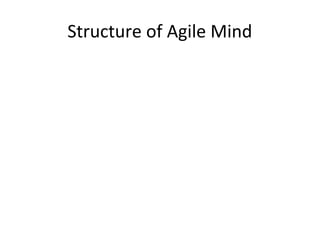
Agile Mind Math Curriculum Guide
- 1. Structure of Agile Mind
- 2. Units 1-3: Functional thinking x and y are variables linked by cause and effect, and this relationship can be represented in various ways Units 4-9: Slope, intercept, and linear models Obtain fluency with moving between representations: tables, graphs, and equations Units 10-14: Solve for unknowns Algebra and systems Units 15-16: Sequences and patterns (we’re skipping) Units 17-18: Exponents Laws of exponents Units 19-23: Quadratics Factoring and finding roots
- 3. Units 1-3: Functional thinking x and y are variables linked by cause and effect, and this relationship can be represented in various ways Article: ‘Functional Thinking as a Route to Algebra in the Elementary Grades’
- 4. An Example: The Trapezoid Problem • Completed in Teacher Study Group • Discussed in a class reading (Blanton & Kaput, 2003) • How many people can sit if there are… – Two trapezoids, – 14 trapezoids, – 127 trapezoids, – n trapezoids? • How do you know? • Can you come up with multiple solutions? 7/07/2011 Sixth Annual Noyce Conference
- 10. Where we’re at this year Semester 1: Functional thinking & graphing Semester 2: Algebra, exponents, and quadratics
- 11. Where we need to be Semester 1: Finish unit 10 by December (currently not till February). Semester 2: Systems, exponents, and quadratics Bottom line: we fell a month behind in Nov/Dec
- 12. Structure of a Unit
- 13. M T W R F Guided Block 1 X Block 3 Assessment X Block 2 X Test X
- 14. Classroom models for Agilemind that work
- 15. Independent Practice • Four students per group • Only one computer out • Students have class sets of activity sheets
- 16. Direct Instruction • NO computers out • Either notebooks or activity sheets • For each slide, students write / draw (especially predictions), then check it. • Students share out answers
- 17. Guided Practice • Assignment is on some instant- feedback site • Students write their answers on whiteboards, so the teacher can monitor • Teacher controls pace of the questions, so that any student who doesn’t have answer on whiteboard has to finish it after class/after school
- 18. Flipping • Pre-recorded tutorial on a problem is played on the board (some teachers are recording their own videos or podcasts) • Students solve either that example, or work a similar example at their desk • Teacher roams the room
- 19. Simulation • Student demonstrates simulation on board, then class does so independently • Students ‘act out’ simulation at end • Article: ‘What levels of guidance promote engaged exploration with interactive simulations?
- 20. What doesn’t work • Giving students an assignment from the agile mind textbook and have them work at their seats – This is the first thing you’d try – It doesn’t work because the students don’t produce anything – It doesn’t work because you wind up being the facebook police, not teaching – Students can change their answers three times, so they just wind up guessing – You’ll get assignment results between 80 and 100%, even though the students haven’t learned a thing.
- 21. Some examples of what I mean by ‘backwards’
- 22. From Unit 3 Test Students must: •Find the rate of change (before we’ve defined rate or slope or practiced any such calculations) •Find the intercept (before we’ve even defined it) •Write an equation in slope-intercept form, even though they’ve never even seen such an equation
- 23. Students must find equivalent expressions, before they have seen a linear equation, been told what a like term is, or even worked on order of operations.
- 24. The a-coordinate? Whoever heard of the a- coordinate? This problem ran throughout. Whenever agilemind used ‘m’ to mean ‘miles’, for example, students with a tenuous grasp of slope got totally lost.
- 25. • Students have roughly two weeks to gain this level of mastery, without the curriculum mentioning algebra beforehand.
- 26. But don’t worry… • Even though only the top 25% might grasp these problems through intuition, agilemind comes back and does the same problem again once students have developed a formal understanding
- 27. From Unit 3 Test From Unit 7 Test From Unit 9 Test
- 28. From Unit 1 Test From Unit 11 Test
- 29. From Unit 2 Test From Unit 10 Test
- 30. • From a math teacher’s normal perspective, you don’t need to teach the same thing again. The skill is the same. • But I found, again and again, that what I thought I was saying, and what the students understood me to be saying, were totally different.
- 31. It’s NOT because these skills were supposed to be prerequisite It’s the intention of the curriculum: students gain a sense of what a function is (in a real- world sense), and how variables are linked by cause and effect. Only after students have been given the context several times, and in fact solved the relevant problem, do they learn the formalism
- 32. Q&A